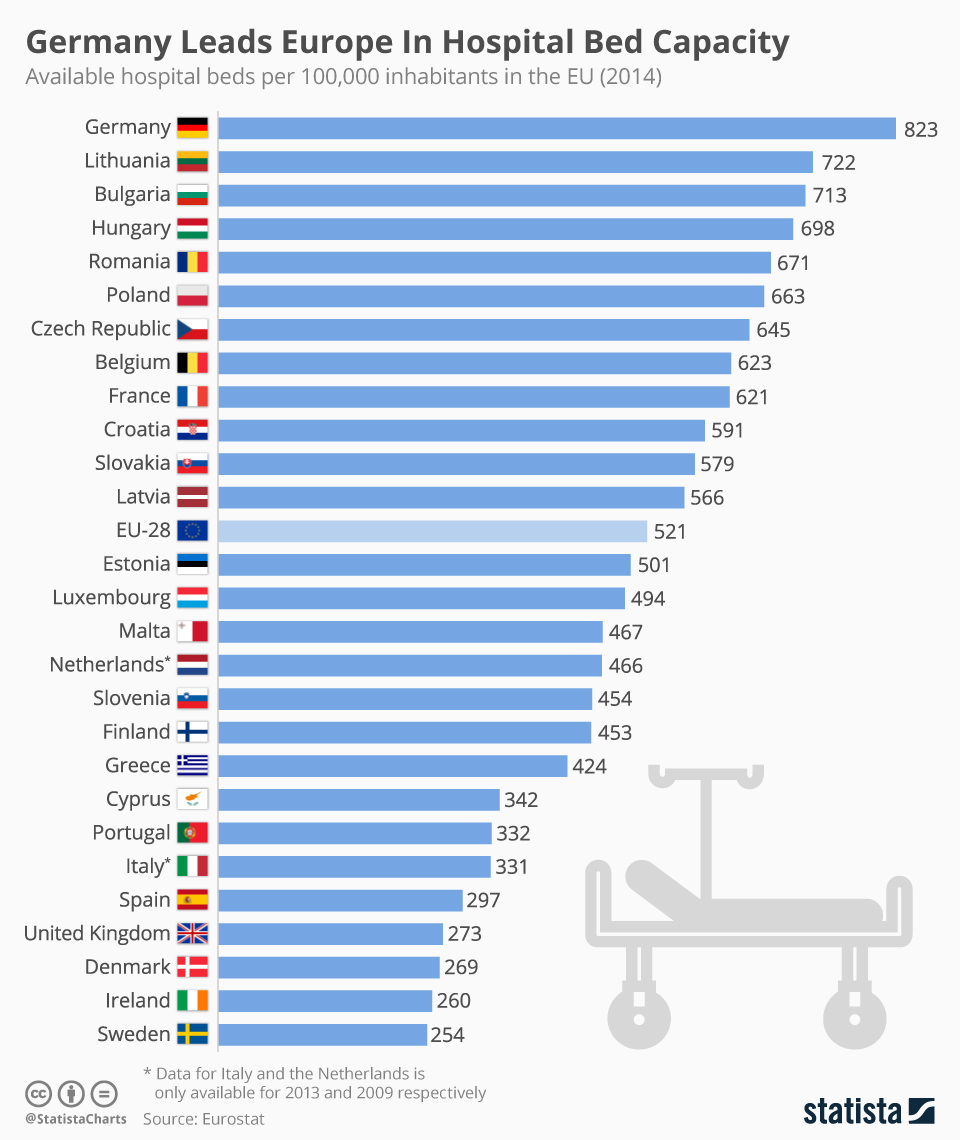[et_pb_section admin_label=”section”]
[et_pb_row admin_label=”row”]
[et_pb_column type=”4_4″][et_pb_text admin_label=”Text”]As worries grow all around the world for a potential second wave, a simple reading of graphs show that Europe is not experimenting a second wave, yet.
With two million cases and 800,000 deaths in Europe within a few months, nations are bringing new health measures and changing everybody’s lifestyle. The most affected countries in the EU, Spain, Italy, witnessed some of the toughest lockdowns in the world. Spain counts an overall of 386,000 cases with 28,000 deaths, a lethality of 7.25% in a country where the median age is 43 years old.
However, countries with almost the same number of cases such as Germany have way less deaths. Why? The answer is natural: hospital beds. In public policy, the importance of health can vary from a country to another depending on the country’s level of welfare interventionism, or the public health system. The statistic to take into account is the number of hospital beds per capita. Other things equal, in situations such as pandemics, the most prepared country is the one that has the best hospital capacity. Germany didn’t implement any lockdown, schools closed but citizens didn’t suffer from any restrictions concerning how much time they can spend outside.

Suppose we relate how much countries are affected by the lethality of the virus to the number of hospital beds. In that case, we can easily understand why countries suffer more than others even if they are on the same level of development. The US, for example, now counting more than 5 million cases has only 728,000 beds in the country, and ⅔ already host someone. Only 242,666 beds are available for a 328 million population.
On the other hand, Germany counts 8 hospital beds per 1,000 inhabitants, for 83 million citizens. If we compare the death rates, the virus killed 176,00 people in the US, whereas it killed 9,000 people in Germany. US deaths represent 21% of worldwide deaths, and the lethality in the country is 3.52%. A relevant number of the health system, where most people can’t afford intensive care costs as they don’t have public health care. Germany however, has a developed health system and has been able to welcome any severe form of sickness caused by the virus, which explained the low death toll.
Second Wave. Another period of intense infection rate? Lockdowns again?
The answer to the first question is unsure. Science isn’t made for betting on the future of a disease. Scientifics aren’t investors, nor prospectors.
The answer to the second is no. Even if more people are getting infected, it doesn’t necessarily mean that hospitals will be overloaded. First, the average age of infected people can decrease, which says that the risks are minors contracting a severe form of the virus. If we look at European figures, 90% of deaths are people over 65-year-old. Also, the youths and teenagers aren’t getting hospitalised, and their immune response is faster and more efficient. In France, none under 19 have died from the virus since March 1st. 6% of infected people between 40 and 59-year-old died from Covid-19. Now, 80% of hospitalised people are over 60. On logarithmic curves, the death rate is still decreasing, getting closer to becoming a flat curve a little over 0—same phenomenon for people receiving intensive care.
On the other hand, if there is an increase in the number of infections, there are two reasons: whether people disrespect sanitary measures (not wearing a mask, gathering with crowds) or people are simply getting tested. France claimed the testing capacity of 700,000 tests per week, which means that everyone with symptoms could get tested. Furthermore, 25% of infected people are without symptoms. Thus, if more people are getting tested, more people are positive. Not presenting symptoms reduces the chances of getting physically affected by the virus; there is less odds to get pneumonia, for instance.

Another reason for not implementing other national lockdowns is that it’s not as useful as it is supposed to be. We now have more figures and more knowledge on the virus, and thanks to all the statistics that have been made, implementing lockdown to youths wouldn’t be efficient in reducing the death toll. The only way to let young people carry on living the same lifestyle is to trace and have data on potential fragile relatives and limiting their contact with people having more chances to contract a severe form of the virus. Locating the weakest would help to protect them without risking economic losses.
Regional lockdowns are another solution. Putting big metropolises such as Paris, London, or Milan under lockdown is a synonym of neutralising the excellent working of an economy and preventing people from losing their jobs.
Linking hospital beds and second waves is crucial in order to understand that a second wave would be less harmful than the first one, and panic isn’t the solution. If Germany is about to face a second wave of infection, they won’t need to put the country under lockdown (they didn’t do it for the first wave) because the increase of infected people doesn’t mean that the virus is killing more nor that it’s getting more severe. And if it’s the case, they have enough beds to welcome the most severe cases of Covid19.[/et_pb_text][/et_pb_column]
[/et_pb_row]
[/et_pb_section]






